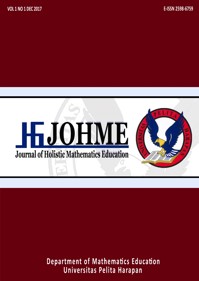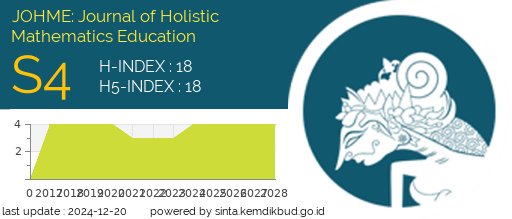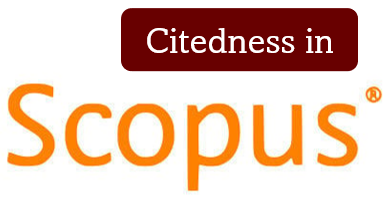Biblical Integration in a Mathematics Classroom: Qualitative Research in a Senior High School
DOI:
https://doi.org/10.19166/johme.v1i1.709Λέξεις-κλειδιά:
Biblical integration, mathematics classroom, senior high school, integrasi Alkitab, kelas matematika, sekolah menengah atasΠερίληψη
This article discusses to what extent mathematics teachers do Biblical integration in their class, explores the challenges that mathematics teachers face when they do or want to do Biblical integration, and explores the school’s expectation of Biblical integration for mathematics teachers with more clarity and intentionality. Research was conducted from September until October 2016. The research subjects were the curriculum coordinator, head of the Department of Mathematics, seven mathematics teachers, and 362 senior high students. The data collection techniques that were used were a semi-structured interview, and a questionnaire. The results of the research showed that the school’s expectation is that teachers should be able show how mathematics is capable of expressing truths about God’s work, God’s beauty, and God’s regularity because God created mathematics. All of the mathematics teachers modeled Biblical qualities. The challenges and obstacles that mathematics teachers were confronted with was that they had little time to find Biblical integration material, they did not have enough understanding, they had difficulty doing Biblical integration from the material, and the teachers were afraid that their explanations about Biblical integration would sound forced to students, especially non-Christian students.
ABSTRAK BAHASA INDONESIA: Artikel ini membahas sejauh mana guru matematika melakukan integrasi Alkitabiah di kelasnya, tantangan dan hambatan yang dihadapi oleh guru matematika saat mereka melakukan atau ingin melakukan integrasi Alkitabiah, dan untuk mencari tahu ekspetasi sekolah tentang integrasi Alkitabiah untuk guru matematika dengan lebih jelas dan mempunyai maksud. Penelitian ini dilakukan dari September sampai Oktober 2016. Subjek penelitian adalah kordinator kurikulum, kepala departemen matematika, tujuh guru matematika, dan 362 siswa sekolah menengah atas. Teknik pengumpulan data yang digunakan yaitu wawancara terencana-tidak terstruktur dan kuisioner. Hasil dari penelitian menunjukkan bahwa ekspetasi sekolah adalah bagaimana matematika mampu menjadi tempat untuk mengantarkan siswa mengenal kebenaran seperti pekerjaan Tuhan, keindahan Tuhan, keteraturan Tuhan karena Tuhan menciptakan matematika. Kemudian, semua guru matematika menjadi contoh kualitas Alkitabiah. Hambatan dan tantangan yang dihadapi guru matematika adalah kekurangan waktu untuk menemukan integrasi Alkitabiah dari materi, mereka juga tidak mempunyai pemahaman yang cukup, mereka merasa kesulitan dalam melakukan integrasi Alkitabiah, dan guru merasa takut jika penjelasannya tentang integrasi Alkitabiah terdengar memaksa bagi siswa, terkhusus siswa yang beragama lain.
Αναφορές
Emzir. (2010). Metodologi penelitian kualitatif: Analisis data. Depok, Indonesia: PT Rajagrafindo Persada.
Gaebelein, F. E. (2009). The pattern of God's truth: The integration of faith and learning. New York: Oxford University Press, Inc.
Knight, G. R. (2009). Filsafat & pendidikan: Sebuah pendahuluan dari perspektif Kristen. Tangerang, Indonesia: Universitas Pelita Harapan Press.
Perspective, C. (n.d.). Christian perspective. Retrieved January 18, 2017, from http://www.christianperspective.net/math/god-and-math-2?utm_expid=4572147-0.0lmOKTHQSkirVXoodUMk_g.1&utm_referrer=https%3A%2F%2Fwww.google.com%2F
Raco, J. (2013). Metode penelitian kualitatif: Jenis, karakteristik dan keunggulannya. Jakarta, Indonesia: Grasindo.
Sugiyono. (2012). Metode penelitian kuantitatif, kualitatif, dan R&D. Bandung, Indonesia: Alfabeta.
Tung, K. Y. (2014). Menuju sekolah Kristen impian masa kini. Yogyakarta, Indonesia: Andi.
Van Brummelen, H. (2002). Batu loncatan kurikulum. Tangerang, Indonesia: Universitas Pelita Harapan Press.
Van Brummelen, H. (2009). Walking with God in the classroom. Colorado Springs, CO: Purposeful Design Publication.
Wiro, H. (2016, October 26). Mochtar Riady: Pendidikan adalah hal utama membangun bangsa. Retrieved December 28, 2016, from http://www.beritasatu.com/ pendidikan/394539-mochtar-riady-pendidikan-adalah-hal-utama-membangun-bangsa.html
Zonnefeld, V. (2015). Practical applications of an integrally Christian approach to teaching mathematics. Perspectives on Science and Christian Faith, 124 - 134. Retrieved from http://www.asa3.org/ASA/PSCF/2015/PSCF6-15Complete.pdf

Λήψεις
Δημοσιευμένα
Πώς να δημιουργήσετε Αναφορές
Τεύχος
Ενότητα
Άδεια
Authors who publish with this journal agree to the following terms:
1) Authors retain copyright and grant the journal right of first publication with the work simultaneously licensed under a Creative Commons Attribution License (CC-BY-SA 4.0) that allows others to share the work with an acknowledgement of the work's authorship and initial publication in this journal.
2) Authors are able to enter into separate, additional contractual arrangements for the non-exclusive distribution of the journal's published version of the work (e.g., post it to an institutional repository or publish it in a book), with an acknowledgement of its initial publication in this journal.
3) Authors are permitted and encouraged to post their work online (e.g., in institutional repositories or on their website). The final published PDF should be used and bibliographic details that credit the publication in this journal should be included.”









